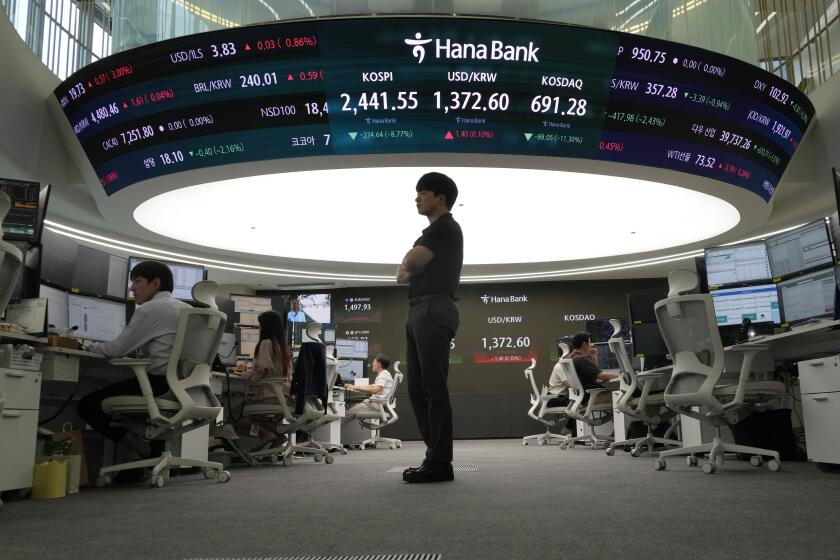Taxes, Inflation, Corruption Sap Vietnam’s Recovery
HO CHI MINH CITY, Vietnam — Tran Van Hung is one of the men Vietnam’s economic renovators are counting on to spur private enterprise, but sometimes he wonders.
“Life is very hard,” moaned Hung in his shoe shop in Cholon, Ho Chi Minh City’s Chinese business district. “With these kind of taxes, my back is going to break.”
According to Hung, municipal tax collectors are hitting him for 60,000 dong a month, up from 1,000 monthly a year ago. “From the earth to the heavens,” he said of the increase.
Hung, 64, lives in the back of the shop with his wife and, he says, gets by on a small pension from his former job with a state brewery. “Maybe,” he consoles himself, “it will be better for the younger generation.”
Vietnam’s economy has never recovered from four decades of war. Now, even the slight advances have turned sour:
- Food production, boosted by reforms in the early 1980s, stalled two years ago in the face of contradictory market policies, natural disasters and continued shortages of fuel, fertilizer, equipment and storage facilities. This year it’s shrinking.
- Factory reforms pushed by the renovating government of Communist Party leader Nguyen Van Linh, who came to power in December, 1986, have met continued resistance from entrenched and corrupt bosses schooled under the old style of centralized management.
- Inflation, curbed last year as the government steadied prices, has zoomed out of control in the past six months. The country’s currency, the dong, has spiraled from 1,000 to a dollar on the black market at the start of the year to more than 3,000 this month.
Said party leader Linh in June: “The national economy has collapsed, largely because the situation of fake profits and true losses has prevailed.”
Linh put the blame squarely on mismanagement, some of it almost farcical.
“Public health, sports and physical education sectors have gotten shipments of fertilizer,” he told his countrymen in a Radio Hanoi broadcast. “Ports (officials) have stolen state goods . . . but the local security agencies are still unable to prevent it.”
Looking for a bright spot, Radio Hanoi described a government textile plant here in Ho Chi Minh City that had cut its work force and still increased production nearly 330%. The director admitted, however, that the plant was still operating at a loss.
Living Standard Skids
Difficult as life is for shoe salesman Hung and other private businessmen here in Ho Chi Minh City, it is worse in the north.
“When I look at Hanoi, my heart cries out,” said Nguyen Xuan Oanh, Vietnam’s primary exponent of foreign investment and an adviser to Linh.
Oanh, vice president of Ho Chi Minh City’s Industrial & Commercial Bank, said the current debacle should be laid to inflation panic rather than the basic structure of the economy.
“The money supply has gone overboard,” he told a group of foreign reporters here.
The result has been another slide in the living standard of the average Vietnamese. On a recent visit to Bangkok, Vietnamese Foreign Minister Nguyen Co Thach commented to his Thai counterpart, Siddhi Savetsila, that the city seemed to be booming compared to his last visit two years ago. Siddhi agreed, but said Thailand had not reached the level of a newly industrialized country because the per-capita income was still less than $3,000.
“It is only about $1,000,” the Thai remarked.
Replied Thach: “We have about $100.”
Hanoi’s economic planners are looking toward a mix of private enterprise and foreign investment to get the economy moving, once the inflation is curbed.
A new foreign investment code promulgated Jan. 1 by the National Assembly permits joint ventures with up to 99% foreign equity, wholly owned foreign enterprises, guaranteed full repatriation of profits and protection against nationalization.
But despite interest from Japanese, South Korean and other businessmen, no deals have been struck, said Oanh, a Harvard-trained economist who worked under the former U.S.-backed regime in South Vietnam. Potential investors are waiting for codification of regulations concerning labor and taxes, among other things.
Problem in Banking
Meanwhile, skilled workers here in Ho Chi Minh City are turning out clothing, shoes and other export consumer goods on an assembly basis, with materials sent in from Soviet Bloc countries and a few Western companies, including firms in France, Italy, Canada and Singapore.
Oanh said a major problem facing the economy is its inflexible banking system.
“The national bank,” he observed, “works like an executive office of the state treasury. If you deposit your money, you can say sayonara to it.”
In place of this “very antiquated sort of system,” Oanh suggested, Vietnam should set up a private network of commercial banks that would circulate money through the economy.
Specifically, he said, he endorses a “one-stop shopping” financial center, including banking, which would handle transactions for foreign investors. But first, he insisted, some sort of “screen mechanism” would have to be established to assure that the investments were beneficial to both Vietnam and the foreign investor.
None of these proposed developments, however, appears likely soon, particularly not until the Vietnamese military has withdrawn all its forces from Cambodia, as it has begun to do this year. The late 1978 Cambodian invasion led to a U.S. embargo on trade with Vietnam.
More to Read
Sign up for Essential California
The most important California stories and recommendations in your inbox every morning.
You may occasionally receive promotional content from the Los Angeles Times.










